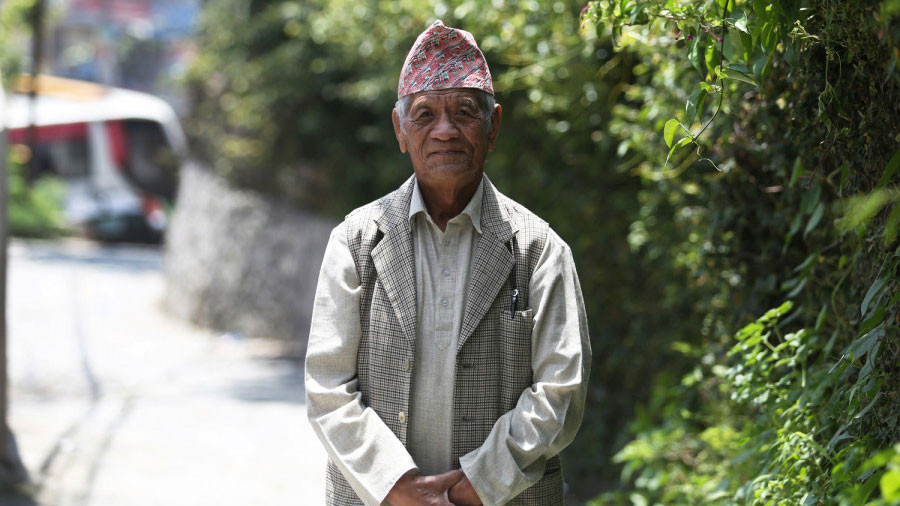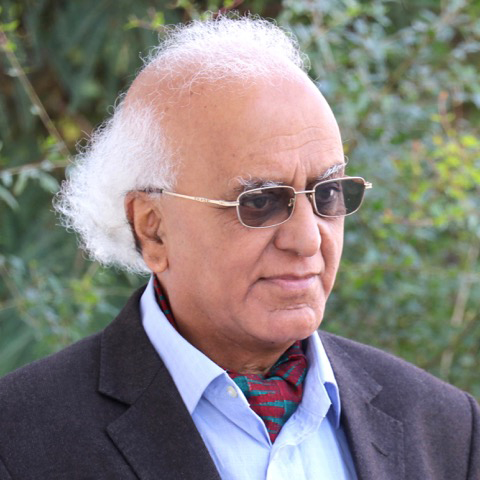Columns
Bairagi Kainla and modernist poetry
Kainla puts the familiar experience alongside the philosophical and mythical allusions.
Abhi Subedi
Modernism is a hugely debated subject in literary discourses in Nepal. Critics and writers bandy about the word adhunik in Nepal's literary discussions. Modernist poets showed that experimentation in poetry was closely related to political and social reforms. Philosophical and political questions, especially about democracy, came alongside the modernist movement. These questions were addressed by modernist Nepali poets and writers of fiction. In this article, I am going to introduce some features of the poetry of a poet named Bairagi Kainla, the nom de plume of Til Bikram Nembang (born 1939). Kainla is the last of the trio of the tesro aayaam group of writers. They even translated tesro aayaam as the third dimensional literary movement that was launched by three writers Indra Bahadur Rai of Darjeeling, and Iswarballabh and Bairagi Kainla of Nepal in 1963. Kainla is the only surviving member of the trio.
I realise I have been writing and publishing works about this subject in Nepali literary criticism and working with graduate students at the university at different times. Some of them have produced very good dissertations in Nepali and foreign universities. Modernism being a very general term, I have specifically chosen the word modernist to discuss the Nepali poetry of the Sixties and early Seventies. I have discussed this with examples in a long introduction to an anthology of Nepali modernist Nepali poets carefully compiled by a team of poets and critics and published by the Nepal Academy under the rubric Pratinidhi Nepali Adhunik Kavita (2010). I have called the poets compiled in this anthology modernist, a term that was used to characterise the poetry of Anglo poets TS Eliot, TE Hulme and Ezra Pound. These poets had a wide ranging influence.
Dominant terms
Though modernism as adhunik is a popular word in Nepali parlance, Nepali political ideologues and thinkers sparsely use it. The dominant terms used frequently and pervasively in Nepali political discourses are Marxism, socialism and democracy. Political parties who claim to be true Marxists use the term overtly. Social scientists and economists use modernism as a structural term in appropriate contexts. I am not going to discuss that here. But what I find important and interesting is that the trio of the tesro aayaam introduced some literary and philosophical concepts about life and perceptions that included the political and social questions naturally.
What strikes me today is their preoccupation with the quest for truth or meaning in life, which they thought could not be reached by using traditional ideas. To them, such concepts were familiar and too simplistic. They are one dimensional, they said. Nothing short of what they called a multidimensional approach to life could explain such phenomena as life, value, aesthetics and art. But the “third dimension” writers’ somewhat convoluted concepts about life did not seem to cohere with what was going on in Nepal. King Mahendra had just introduced a non-party political system called Panchayat when they started the movement, and BP Koirala had just been sent to Sundarijal prison.
Students and readers of culture use Bairagi Kainla’s cultural oeuvre—the translations and interpretations of Limbu Mundhum. I think it is important to mention the titles that researchers may find important for their work. They are Falgunandako upadesh ra satyahangma bhajan mana (2047), Limbu jatima Kokh-puja (Limbu, Nepali 2048), Nahen Mundhum: Irshya ra Ankhidahiko Akyan ra Anusthan (Limbu Nepali 2051), Samsodha Mundhum: Pretatmako Akhyan ra Anusthan (Limbu Nepali 2051), Sasik Mundhum: Mochmarne Akyan ra anusthan (Limbu Nepali 2051), Tangsing Takma Mundhum: Aakhyan ra anusthan (Limbu Nepali 2052), and Nawa Chait Mundhum (Limbu Nepali 2060). The main thrust of Bairagi Kainla in these Mundhums is to explore the mytho-poetic power of them. This is a good body of work. Collections of his poems have been published at different times. Bairagi Kainlaka Kavita or the Poems of Bairagi Kainla is the most familiar one.
Bairagi Kainla closely followed the metaliterary thinking of his senior in the group Indra Bahadur Rai, a fiction writer, critic and theorist who advocated the concept of interart studies. Bairagi Kainla has attempted to interpret Rai's literary theory. He makes the interpretation of Indra Rai's ideas with a purpose to accentuate the relevance of their writings and styles of the decade of the Sixties of the last century. Another member of the trio Iswarballabh combined lyricism with erudition in poetry. He was prolific about his metapoetic perceptions. His poems closely resemble those of the poetry of Mohan Koirala famously known as a great experimentalist. A cohort of the tesro aayaam poets with other poets of that time like Tulasi Diwasa, Dwarika Shrestha, Madan Regmi, Krishnabhakta Shrestha, Ratna Thapa, Pushkar Lohani, Parijat and Upendra Shrestha marks an important modernist period in Nepali poetry.
English translation
Bairagi Kainla, now frail and less mobile, wants to project his poems to a wider audience by opening discourses among the younger generation of writers or by getting his poems translated into English. Kainla sent me a poem for English translation. This long poem that I translated as “My story and me are different” has allusions to the above mentioned “Mundhum”. It was not easy to translate this poem into English; but while translating it, I realised that it speaks the essence of Kainla's poetic journey, it's a minuscule self-storying epic imagination after his well-known poems "Ganga Neelo Bagchu" and “Planchetko Table". The titles of the poems evoke Bairagi Kainla's metapoetic writing. Each of his poems is a conscious creative effort that evokes the poetic side of the familiar world. But Bairagi Kainla puts the familiar experience alongside the philosophical and mythical allusions. Such writing reminds us of the metapoetic style of the earlier poet dramatist Balakrishna Sama who considered the intellectual element as the beauty of the poem. Sama called this a phenomenon of intellectual tenderness or baudhik komalta, cited as his definition of poetry.
It is interesting to see how modernism and experimentalism did have a lesser appeal for writers of the later generation. I would see that as a shift in the perception of the writers of the young generation who had wider openings, one among which was of a political nature. Modernism as espoused by writers, especially poets, was a way of seeking an outlet from the Panchayat political system that closed many frontiers of expression for them. Poets felt that more than writers of other literary genres. But then, such writing became their forte and a way of self-expression. But as the case of poet Bairagi Kainla shows, it became the mode and means of their creative writing. Therefore, focus on the poetry and mythopoetic exercise of Bairagi Kainla is an important subject.




 9.12°C Kathmandu
9.12°C Kathmandu















